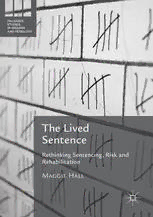
The Lived Sentence: Rethinking Sentencing, Risk and Rehabilitation PDF
Preview The Lived Sentence: Rethinking Sentencing, Risk and Rehabilitation
Palgrave Studies in Prisons and Penology Series Editors Ben Crewe Institute of Criminology Cambridge University, Cambridge, United Kingdom Yvonne Jewkes School of Applied Social Science University of Brighton, Brighton, United Kingdom Thomas Ugelvik Dept. of Criminology & Sociology of Law University of Oslo Oslo, Norway fi This is a unique and innovative series, the rst of its kind dedicated entirelytoprisonscholarship.Atahistoricalpointinwhichtheprison population has reached an all-time high, the series seeks to analyse the form, nature and consequences of incarceration and related forms of punishment. Palgrave Studies in Prisons and Penology provides an important forum for burgeoning prison research across the world. Series Advisory Board: Anna Eriksson (Monash ff University), Andrew M. Je erson (Rehabilitation and Research Centre for Torture Victims), Shadd Maruna (Rutgers University), Jonathon Simon (Berkeley Law, University of California) and Michael Welch (Rutgers University). More information about this series at http://www.springer.com/series/14596 Maggie Hall The Lived Sentence Rethinking Sentencing, Risk and Rehabilitation MaggieHall IndependentAcademic Sydney,Australia PalgraveStudiesinPrisonsandPenology ISBN978-3-319-45037-7 ISBN978-3-319-45038-4(eBook) DOI10.1007/978-3-319-45038-4 LibraryofCongressControlNumber:2016950019 ©TheEditor(s)(ifapplicable)andTheAuthor(s)2016 Thisworkissubjecttocopyright.AllrightsaresolelyandexclusivelylicensedbythePublisher,whether thewholeorpartofthematerialisconcerned,specificallytherightsoftranslation,reprinting,reuseof illustrations, recitation, broadcasting, reproduction on microfilms or in any other physical way, and transmission or information storage and retrieval, electronic adaptation, computer software, or by similarordissimilarmethodologynowknownorhereafterdeveloped. Theuseofgeneraldescriptivenames,registerednames,trademarks,servicemarks,etc.inthispublica- tiondoesnotimply,evenintheabsenceofaspecificstatement,thatsuchnamesareexemptfromthe relevantprotectivelawsandregulationsandthereforefreeforgeneraluse. Thepublisher,theauthorsandtheeditorsaresafetoassumethattheadviceandinformationinthis book are believed to be true and accurate at the date of publication. Neither the publisher nor the authorsortheeditorsgiveawarranty,expressorimplied,withrespecttothematerialcontainedherein orforanyerrorsoromissionsthatmayhavebeenmade.Thepublisherremainsneutralwithregardto jurisdictionalclaimsinpublishedmapsandinstitutionalaffiliations. Coverillustration:©DavidWhite/AlamyStockPhoto Printedonacid-freepaper ThisPalgraveMacmillanimprintispublishedbySpringerNature TheregisteredcompanyisSpringerInternationalPublishingAG The registered company address is: Gewerbestrasse 11, 6330 Cham, Switzerland Contents 1 Introduction 1 1.1 Core Hypotheses 6 2 The Socio-Political Context of Imprisonment in New South Wales 19 2.1 Introduction 19 2.2 Major Enquiries 21 2.3 Popular Sensibilities and Penal Politics 24 2.4 Expansion of the Prison Estate 27 2.5 Transmission/Extension of Penal Relations 29 2.6 Evaluation and Accountability 32 2.7 Legislative Changes 34 “ ” 2.8 Risk + What Works = A Limited Version of Rehabilitation 40 2.9 Conclusion 43 3 Theorising Sentencing 47 3.1 Introduction 47 3.2 Sentencing in NSW 55 3.3 The Aims of Sentencing in NSW 58 3.4 Risk and NSW Courts 77 3.5 Conclusion 88 v vi Contents 4 Experiencing Sentencing 91 4.1 Introduction 91 4.2 Reasons for Judgment and Remarks on Sentence 94 4.3 Prisoners and Sentence Comments/Remarks 95 4.4 Remorse in Criminal Justice 103 4.5 Conclusion 115 “ ” 5 Managerialism, Discipline and the Responsible Prisoner 117 5.1 Introduction 117 5.2 Managerialism and the Department of CSNSW NSW 118 5.3 Prison as Management of Bodies 123 fi 5.4 Processes of Sorting, Classi cation and Management 131 5.5 Discipline, Resistance, Compliance and Punishment 146 5.6 Special Regimes 154 5.7 Case Management, Throughcare and SORC 158 5.8 Individualisation and the Responsible Prisoner 164 5.9 Conclusion 167 6 Relational Aspects of Imprisonment 169 6.1 Introduction 169 – 6.2 The Relational Aspects of Life in Prison Conceptions “ ” of Prison as Community 171 6.3 Dimensions of Personal Identity 194 6.4 Conclusion 206 7 Rehabilitation 209 7.1 Introduction 209 7.2 What Does It Mean? 212 — 7.3 The Hall of Mirrors Risk and Responsibility 228 7.4 Rehabilitation + Risk = Cog Skills 238 7.5 Conclusion 249 8 Conclusion 251 — 8.1 Theorising the Gap Legal Sentencing and Penal Practices 253 8.2 The Interviews 257 Contents vii — 8.3 The Impact of Risk Focused Managerialism Imaginary Sentences? 264 8.4 Conclusion: The Lived Sentence as Communication: The Devil in the Detail 267 Bibliography 269 Index 293 List of Abbreviations AVL Audio-visual link CALD Culturally and linguistically diverse CORE Low-risk sex offender programme CSNSW Corrective Services NSW (formerly Department of Corrective Services NSW) CUBIT Custody-based intensive therapeutic programme (high risk) DPP OfficeoftheDirectorofPublicProsecutionsNSW EHR Extreme high risk EPRD Earliest possible release date HRMU High-risk management unit NESB Non-English speaking OPM Operations procedure manual, DCNSW PRLC Program review leave committee (a division of SORC) SMART (SMART USself-helpdrugandalcoholprogrammedesigned RECOVERY (TM)) as an alternative to12-stepprogrammes SORC Serious offenders review council VOTP Violent offenders therapeutic programme ix 1 Introduction The atmosphere in the Parole Authority hearing room was heavy, the screen on which the prisoner appeared was fuzzy and crackling, ’ fi the prisoners halting speech intensi ed by the poor reception. The ’ judge, having listened to the prisoners legal representative list the litany of prisons he had occupied over the past eight years, the lack of opportunities to participate in rehabilitation programmes and the fracturing of already tenuous family relationships by the constant “ movements, frowned. Suddenly he exclaimed, Goodness, what have ” they done to my sentence?! The prisoner peered through the screen, recognising the judge who had sentenced him eight years before. In the sentencing remarks the judge had made a comprehensive list of recommendations as to how this young man was to be assisted to appreciate the wrong he had done, and left a long period on parole for him to be integrated into the community. The judge could see how little had been implemented and the Authority had no choice but to refuse parole. Even if the prisoner was able to complete the rehabilitation which was recommended and was successful in gaining release, he would have no time left for a period of parole to reintegrate him into the community. © The Author(s) 2016 1 M. Hall, The Lived Sentence, Palgrave Studies in Prisons and Penology, DOI 10.1007/978-3-319-45038-4_1
